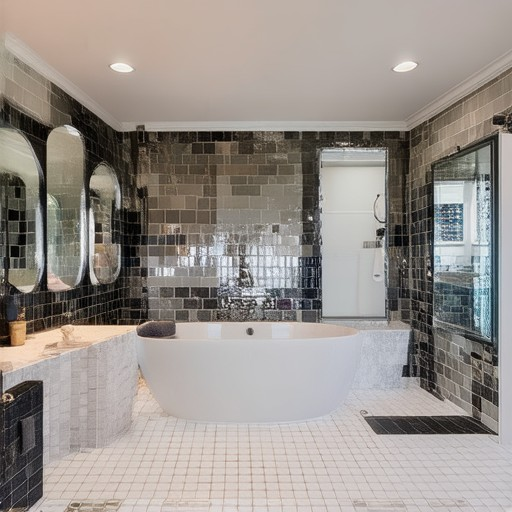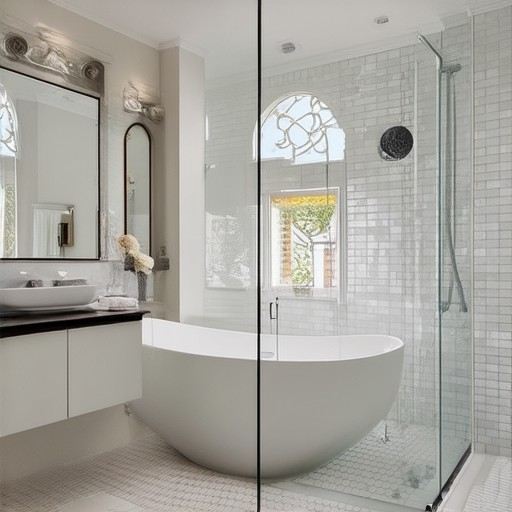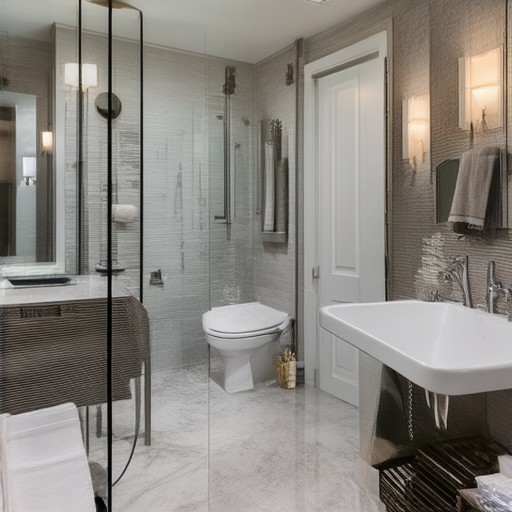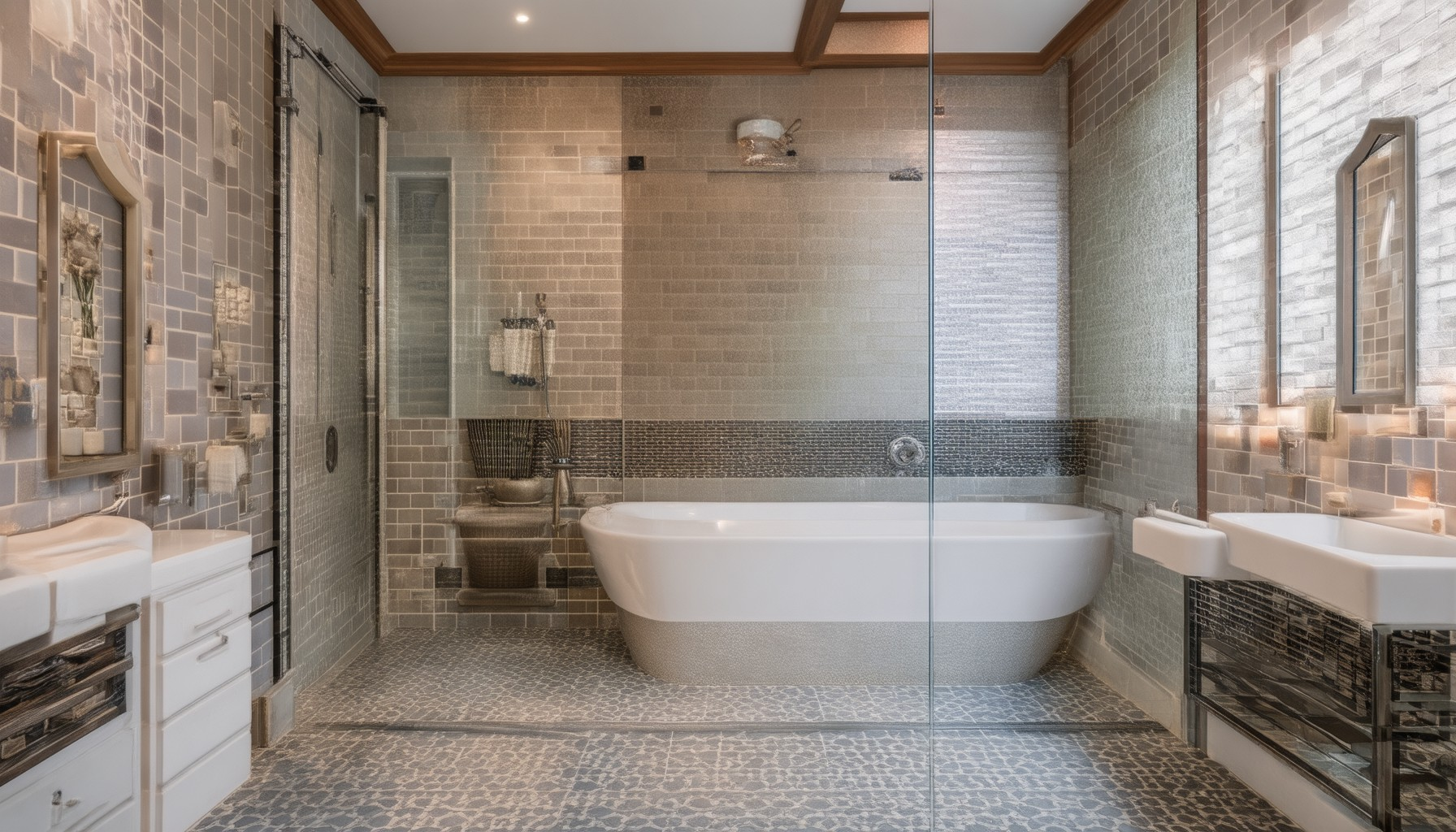Welcome to the world of modern bathroom design where every detail matters. In 2024, bathroom tile choices are more than just functional—they’re a statement of style. Whether you’re remodeling your space or simply looking for fresh ideas, this guide will walk you through the latest trends, expert tips, and creative approaches to designing a bathroom that feels both luxurious and cohesive. From geometric patterns to large-format tiles, from bold color statements to subtle neutrals, we’ve got you covered. Discover how the right bathroom tile ideas can transform your space into a sanctuary of relaxation and elegance. Ready to dive in? Let’s explore the trends, sizes, and color palettes that are shaping the future of bathroom design.

Bathroom Tile Trends 2025
The bathroom remains a focal point of modern home design, with tile trends continually evolving to reflect contemporary aesthetics and functionality. Here are the key trends shaping bathroom tile designs in 2025:
- Geometric Patterns : Bold, asymmetrical geometric patterns are making waves in bathroom tile design. These patterns add visual interest and a sense of movement to the space.
- Large-Format Tiles : Larger tiles are gaining popularity, offering a minimalist and spacious feel. They are ideal for small bathrooms and are available in various textures and colors.
- Textured Finishes : Textured tiles add depth and dimension to walls, mimicking the look of natural materials like stone or wood. This trend is perfect for creating a sophisticated vibe.
- Natural Materials : Tiles inspired by natural stones, such as marble and travertine, continue to dominate, offering a timeless elegance to bathroom settings.
- Colorful Mosaics : Vibrant mosaics are becoming a statement feature in bathrooms, adding a pop of color and transforming the space into a visual masterpiece.
- Sustainable Options : Eco-friendly tiles made from recycled materials are increasingly popular, aligning with global sustainability goals and reducing environmental impact.
Competitors like Dalleys Tile & Grout , Kendall Tile , and Marley Tile are also capitalizing on these trends, offering diverse collections that cater to different design preferences. Whether you prefer a classic or modern look, there’s a tile option to suit every style.
The 1/3 Rule for Tile Installation
The 1/3 rule refers to a specific method of installing tiles where the edge of each tile is offset by one-third of its width in alternating rows. This technique creates a subtle yet visually appealing alignment that differs from the traditional half-offset bricklaying method.
- Visual Effect: The 1/3 offset creates a tighter, more uniform appearance compared to the standard half-offset, which can sometimes result in visible gaps or misalignment.
- Practicality: This method is often chosen for its professional finish and ability to minimize the visual impact of grout lines, making it ideal for walls, floors, and countertops.
- Application: To achieve the 1/3 offset, installers typically measure the grout width first. Once determined, the next row of tiles is offset by one-third of the tile’s width relative to the previous row.
- Benefits: The 1/3 offset can enhance the overall aesthetic appeal of tiled surfaces, making them appear more polished and aligned, regardless of the tile size or shape.
For those looking to achieve this specific look, consulting with a professional installer or referring to detailed guides on tiling techniques can provide further insights and ensure optimal results. Visit our tile installation guides for more information and step-by-step instructions.

What Size Tile is Best for a Small Bathroom?
Choosing the right tile size for a small bathroom is crucial to creating a sense of space and ensuring functionality. Here’s a breakdown of the best options:
- Tile Layout Options: – 12″ x 12″: A compact size that fits well in tight spaces, offering a balanced look without overwhelming the room. – Larger Formats (16″ x 16″): Can work if the bathroom is slightly larger, providing a modern, sleek appearance.
- Tile Types: – Ceramic Tiles: Durable, moisture-resistant, and easy to clean—a top choice for bathrooms. – Glass Tiles: Adds a touch of elegance but requires careful handling due to fragility. – Natural Stone Tiles: Offers a luxurious look but may be heavier and more difficult to install.
- Grout Lines: – Wider grout lines (1/2″) can visually expand the space, while narrower ones (1/4″) emphasize the tile size.
- Color Choices: – Lighter tones can make the room feel larger, whereas darker hues may make it seem more confined.
- Design Ideas: – Use smaller tiles in high-moisture areas for better water resistance. – Opt for large-format tiles in the shower for a spa-like feel. – Incorporate vertical stripes or feature walls to divert attention from the room’s size.
- Considerations: – Larger tiles may lead to installation challenges and higher costs. – Always consult professionals for advice tailored to your specific space.

Best Color for Bathroom Tile
Choosing the right color for bathroom tiles involves considering factors like lighting, size, and personal style preferences. Here’s a breakdown of the best options:
- Light Colors: Light shades like white, beige, and soft gray are ideal for small bathrooms as they make the space feel more open and airy. They also reflect natural light effectively.
- Dark and White Combination: Black and white tiles create sharp contrast and offer a timeless look, perfect for modern or classic bathroom designs.
- Pastel Tones: Pastel colors like blue, green, or pink add a touch of color without overwhelming the space, making them great for those who want to experiment with color but prefer subtlety.
- Bold and Daring Choices: For a more adventurous look, consider deeper hues like navy blue, charcoal gray, or muted teal. These colors add depth and personality while still maintaining a sophisticated vibe.
For additional guidance on selecting the perfect bathroom tile colors, check out our Bathroom Tile Color Guide and explore our Bathroom Design Ideas collection for inspiration and expert tips.
Should Tile Be Lighter or Darker Than Walls?
When deciding whether to choose lighter or darker tiles compared to your walls, there are several factors to consider to create a cohesive and visually appealing space. Here’s a breakdown of the key considerations:
Color Contrast and Lighting
- Light vs. Dark Tiles : The contrast between your tiles and walls plays a significant role in the overall aesthetic. Light-colored tiles can brighten up a room, while dark tiles can add depth and sophistication. The choice depends on the natural light in the room and the mood you wish to evoke.
- Neutral Tones : If you prefer a balanced look, opt for tiles in neutral tones that complement your wall color. This approach ensures a harmonious balance without overwhelming the space.
- Dark Wall Colors : If your walls are dark, lighter tiles can help counterbalance the heaviness of the walls, making the space feel airier. Conversely, darker tiles can enhance the dramatic effect of dark walls, creating a more moody ambiance.
Design Style and Room Function
- Traditional Spaces : In traditional settings, lighter tiles often complement darker wall colors, creating a classic contrast that enhances texture.
- Modern Interiors : Modern designs frequently pair light-colored tiles with dark walls to create a sleek, contemporary look. This combination highlights architectural features and adds visual interest.
- High-Traffic Areas : For busy areas like kitchens or bathrooms, lighter tiles are generally easier to clean and maintain, making them a practical choice.
- Personal Preference : Ultimately, the decision should align with your personal style and the intended atmosphere of the room.
Choosing the Right Color Scheme
- Warm Tones : Light-colored tiles with warm undertones can complement rich, deep wall colors, creating a welcoming and cozy environment.
- Cool Tones : Dark tiles with cool undertones can balance out warm-colored walls, offering a refreshing contrast.
- Monochromatic Looks : For a minimalist appearance, stick to a monochromatic palette by selecting tiles and walls in shades that blend seamlessly together.
Practical Tips
- Test Samples : To ensure the color scheme works, test tile samples against the wall color in different lighting conditions.
- Professional Advice : Consider consulting with a designer or color expert to explore complementary color palettes tailored to your space.
- Longevity : Keep future updates in mind. Light-colored tiles are easier to update with changing decor trends.
For more inspiration and design ideas, explore our tile design gallery or visit our wall color guide . Let us help you create a space that truly reflects your personality!

What Color Tile Makes a Small Bathroom Look Bigger?
Choosing the right color for your bathroom tiles can significantly impact the perception of space. Here’s how you can select tiles that make your small bathroom feel larger:
- Opt for Light Colors : Light-colored tiles, such as whites, creams, or soft grays, reflect more light, making the room appear more spacious. Darker tones absorb light, which can make the space feel smaller.
- Use a Neutral Palette : Stick to neutral colors like beige, light gray, or taupe. These colors don’t overwhelm the senses and contribute to an airy feel, making the room seem larger.
- Larger Tile Sizes : Incorporate larger tiles, such as 12×12 inches or rectangular tiles, to minimize grout lines and create a sleek, expansive look. Larger tiles can make the room feel less crowded.
- Consider Tile Layout : Arrange tiles in a way that maximizes vertical space. Vertical layouts or diagonal patterns can elongate the room, giving it a sense of height and width.
- Complementary Accents : Add subtle accent tiles in a lighter shade to draw attention away from the walls, focusing on the openness of the space.
By thoughtfully selecting light-colored, large-format tiles in a neutral palette, you can effectively make your small bathroom feel more spacious and inviting.





0 Comments